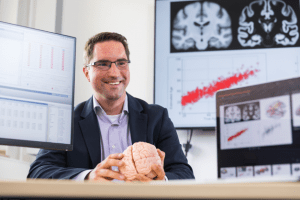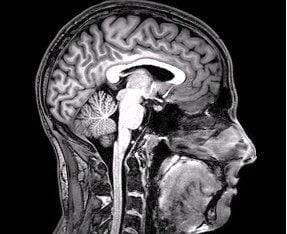“Can we predict mental traits? Can we predict your personality, your cognitive abilities, your disorders based on brain imaging data?”
An interview with Simon Eickhoff
Institute of Neuroscience and Medicine (INM-7)
Heinrich-Heine University Düsseldorf
By: Michelle Johnson (11/22/19)
Did you always know you wanted to work in scientific research?
When I was in 9th or 10th grade, I had to write an application to spend a year in the U.S. as a Fulbright scholar, and, at the time, my answer to the question, “What do I want to do in the future?” was “biomedical research.” Then at the end of high school, however, I was quite unsure. In Germany we have either military or civil service so I spent a year as an assistant in a surgical operation theater and I liked working in the hospital. So, I decided I would study medicine. I did and then got into research through my doctorate thesis and just stayed there in the end.
Do you think that’s a common path for many scientists?
I think there are two main paths people have. There are the ones who know very early that that’s what they want to do, and they structure all of their life, all of their CV, around it. I also think there’s quite a few people like me who have several interests. It’s often through coincidences that they find a topic they like and continue to do it.
What questions are most exciting to you at the moment?
What [the Institute of Neuroscience and Medicine (INM-7)] does at the moment, and what I’m really excited about, is trying to answer the questions, “Can we predict mental traits? Can we predict your personality, your cognitive abilities, your disorders based on brain imaging data?” This is exciting from a purely scientific perspective, but it also has a huge range of potential applications. The medical application is obviously the biggest one because ultimately one would like to be able to tell a patient, “This is your future prognosis. You should ideally take this medication because it gives you the highest chance to recover.”
There are also a lot of applications outside of medicine. You could [use it] in any situation in which somebody has to make a judgment that is ultimately about the inner trait of another person. This could also be a a judge, somebody in human resources or somebody in the social security system. When a person has to decide something they cannot directly observe because it’s in [another person’s] head—can we solve this problem through brain imaging?
I do have to stress that at the moment we are really working on, “Can we do it?” We are not yet at the level of, “How can we implement this into general practice?” It’s still a long way to go. I think that’s really important to highlight: we are not there yet, but we feel that we can get there in the future.
What has your experience been like creating and engaging in a scientific community?
Lab culture in the INM-7 is a very interesting because we have always been an extremely international group. We have 19 different nationalities in our Institute; that is absolutely exciting, but it also comes with certain challenges. You can’t expect a common cultural background; you’re almost working in an abstract space because there’s no common background in terms of music, what kind of jokes they make, pop culture references, what kind of analogies they understand. These are the little things that you become much more aware of if you have a very international group. But it is also interesting because you can build a culture around personal relationships and common goals.
What’s the best piece of advice you’ve received?
Science is a multi-short, long-term game. It’s usually better to get along with people, even if you feel that you are getting the shorter end at the moment, because you will revisit each other many times. It’s often worse to pick a fight even if you feel that you’re right because the long-term benefit of staying on a good relationship is usually more helpful and important.
To learn more about Dr. Eickhoff and his work, click here.
Click here to go back to the “Interviews with Scientists” page.

